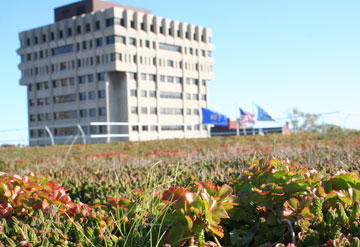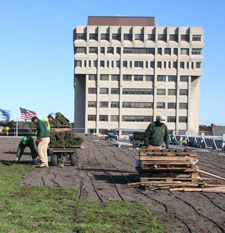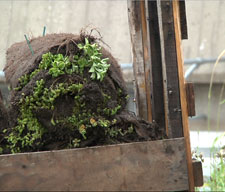
Campus may not look much different from the ground, but a crop of thick sedum now covers 50,000 square feet atop the Golda Meir Library. Nearly complete, it’s the largest green roof on a public building in Wisconsin, and the fourth and the largest green roof at UWM.
A ribbon-cutting will be held on Campus Sustainability Day, Tuesday, Oct. 18, at 2 p.m. in the fourth floor Conference Room in the library. The planting, which tops the third floor of the West and East wings, is visible from the fourth floor.
The green roof project was made possible through a partnership with the Metropolitan Milwaukee Sewerage District (MMSD). The 30-kilowatt system of solar cells that is also part of the project was sponsored by WE Energies with the support of Focus on Energy grants.
Along with completion of the library’s green roof, this summer’s project included expansion of a green roof on the Sandburg Commons building, which is now more than 33,000 square feet.

Another green roof, installed in 2003, covers about 7,600 square feet of the WATER Institute’s lower roof. In 2007, the student environmental organization Ecotone put in a 175-square-foot green roof adjacent to the east end of the Maryland Avenue footbridge.
The green roofs initiative began when Jim Wasley, associate professor of architecture, and his students launched a “storm-water master plan” in 2005. Wasley helped design the Golda Meir project and says the ultimate aim is to cut the amount of storm-water runoff pouring from pavement and roofs and washing surface pollutants into Lake Michigan.
“This will help Edgewood Avenue, where a lot of flooding takes place,” says Wasley, who has also submitted a proposal to the Environmental Protection Agency involving a multiyear Monitoring, Research and Education Initiative.
UWM’s profile is rising in green circles. In 2010, UWM made the Princeton Review’s Green Colleges List, a guide to 286 institutions that have demonstrated an exemplary commitment to sustainability. The list was compiled by both the Princeton Review and the U.S. Green Building Council.
“We are very excited about this new addition to our building,” says Ewa Barczyk, director of libraries. “It complements all the green features and practices incorporated into our recent Daniel M. Soref Learning Commons remodeling project, including the re-use of doors and windows, a reliance on daylight rather than artificial light where possible, low VOC paint and flooring, and the recycling of over 75 percent of the demolished portions of the building.”

In addition to the ribbon-cutting, Campus Sustainability Day will feature two other green activities:
7:30-10 a.m. The Organic Pancake Breakfast in the Union Ballroom East is open to all, but free to students. Winners of the Reduce Your Use Energy competition in the residence halls, which ran from Sept. 25 to Oct. 8, will be announced at the breakfast. Follow the competition on the university’s sustainability dashboard, which tracks energy consumption: http://buildingdashboard.net//uwm/.
4-6 p.m. The Green Book Club will feature a reading and discussion of Dr. Seuss’s “The Lorax” in the Wisconsin Room Lounge. Check out the sustainability website or Facebook for other information: www.sustainability.uwm.edu.



